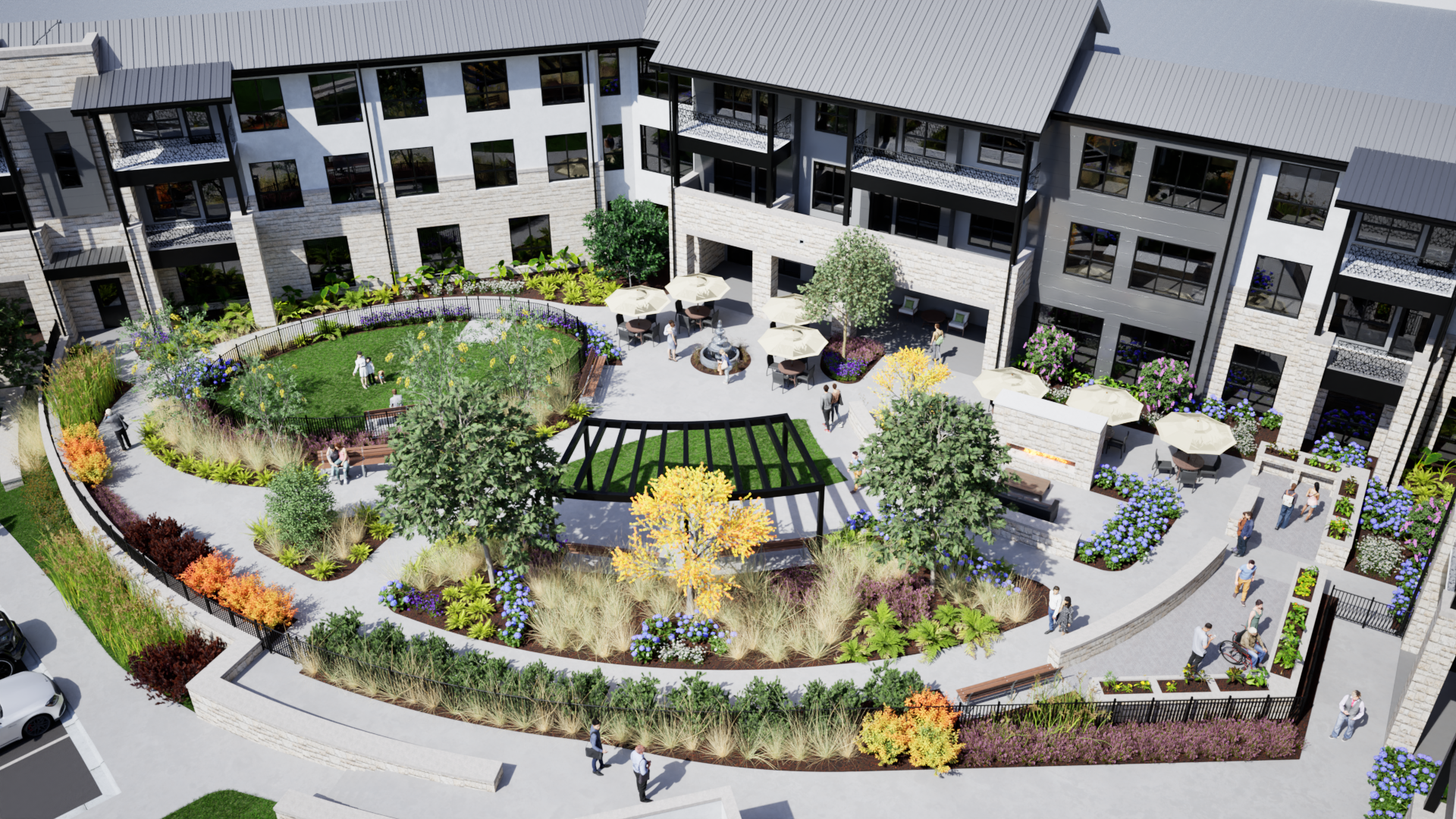Designing for Dementia - It’s in the Details
When you talk to people living with dementia and their families, it is clear that they face numerous challenges. However, there are no easy solutions. It isn’t always desirable to go into a nursing home or even an assisted living facility, and it can be difficult to keep them at home. We can help by creating and promoting design elements that make it safe and comfortable for individuals with dementia and their families wherever they are.
Key design considerations for senior living and other community-living buildings and campuses:
Reduce navigation challenges. Smaller buildings or units can make it easier for residents to navigate and keep them from getting lost or wandering. Doors and hallways that have distinct colors or markings, as well as clear signage, also can help people from getting lost or confused. Some buildings are designed in essence like “giant donuts,” so residents always end up where they started if they get lost or confused.
Make the best, most efficient use of technology. It is important to use technology in an effective yet non-invasive manner. For instance, proximity sensors can detect the presence of objects electronically without touching them and can be used to trigger an alert if, for instance, someone enters or exits a building or space.
Integrate indoor and outdoor spaces. The benefits of spending time outdoors and connecting with nature – including increased calm and improved mood and sleep -- have been well-documented in the literature; so, it is essential that people living with dementia have access to outdoor spaces. Consider beautifully landscaped patios and courtyards that are easy to get to but also discourage or prevent wandering. Raised gardens can enable people, even those with physical limitations, to continue a love of growing things and digging in the dirt. Avoid plants that would be poisonous if eaten; instead, consider edible foliage and flowers that won’t harm residents if they consume them.
Be thoughtful about decorative elements. Busy art, such as abstract art with bold splashes of color, may be upsetting for people living with dementia. Instead, consider art that depicts bucolic, familiar, comforting scenes. Photos that take people back to happier times can trigger positive memories and joyful feelings. People with dementia may want to touch things on the wall, so tactile or interactive art may be useful. Of course, you don’t want wall hangings or sculptures that could be pulled off or knocked over and injure someone.
Enable activities as well as quiet times. It is important to create spaces that keep people engaged, such as multipurpose rooms that can be used for concerts, games, yoga/exercise classes, etc. Spaces where people can create – paint, sculpt, and draw – are important, as well as areas for pursuits like woodworking, sewing, and knitting. At the same time, it is important to have spaces for quiet time, such as a conservatory, sunroom, greenhouse, meditation garden, etc. Sunlight is an important contributor to positive mood, so there should be plenty of open spaces with windows that let in the light and enable residents to look out at the world.
Maintain a homelike environment. The more the community/building/apartment resembles home, the more comfortable residents, especially those with dementia, are likely to be. Furniture should be comfortable and inviting, flowers and plants should be lush but easy to maintain, and residents and families should be encouraged to decorate private spaces with personal photos, art, mementos, and other things that are comforting and familiar. A family photo or a favorite quilt can be a great source of joy and happy memories for someone living with dementia.
Stick to design basics. Keep flooring and walling simple. Contrasting colors or textures can contribute to falls, particularly for residents with impaired vision. Lighting in hallways should be bright but not glaring; therapeutic lighting that is designed to mimic natural daylight can contribute to positive moods and better sleep-wake cycles. Wall colors can impact mood. Traditionally, shades such as soft blue, subtle green, and gentle gray evoke feelings of peace and relaxation. Brighter colors such as teal, melon, and lemon are more energizing.
Attend to sound. Residents may be affected by the sound. Some may be sensitive to noise, so spaces – especially those adjacent to rooms where there is likely to be loud conversation, music, entertainment, etc. – should be as soundproof as possible. Acoustics in all rooms should enable group as well as private conversation. Some residents enjoy sound, so headsets that enable people to enjoy personal or shared music, fountains, white noise machines, and/or an aviary with songbirds can offer comfort and evoke pleasant thoughts.
Have safe ways to enable connections with pets and other animals. Some communities enable residents to keep their pets if they can continue to care for them. When this isn’t possible, it’s important to enable programs where pets can come in to visit residents. Activities such as visiting a petting zoo or an annual ‘county fair’ with llamas, bunnies, and goats are increasingly popular. At any rate, it is important to have easy outdoor access for dogs and other animals, as well as flooring and furniture that is easy to clean and keep sanitized.
Cognitive impairment and dementia are growing issues in all settings where older adults live. We need to move past the stigmas associated with dementia and create environments where people can thrive and enjoy the best possible quality of life. In design and programming efforts alike, we need to focus on what people living with dementia can still do while accommodating their deficits. The result will be homes that are places of joy for residents and their families alike.
Many of these tips are also applicable to independent living, multigenerational living, and private homes for people living with dementia and their caregivers. At the same time, there are a few design elements that can keep people safer and more comfortable in these environments as well:
Avoid tripping hazards. Limit the use of rugs, furniture, or steps that can present a fall risk.
Enable, as possible, easy outdoor access. Create an inviting but safe external space such as a fenced yard or gated patio. If the person loves gardening, give them an outlet such as a raised flower box and an herb garden.
Prioritize technology that doesn’t invade the person’s privacy but promotes safety. Stoves with automatic shutoffs, wearable GPS tracking devices, emergency alert devices, smart locks, motion detection lights, and virtual assistant devices have grown in popularity.










